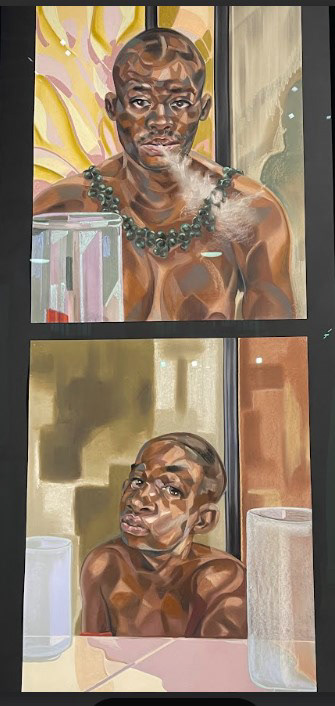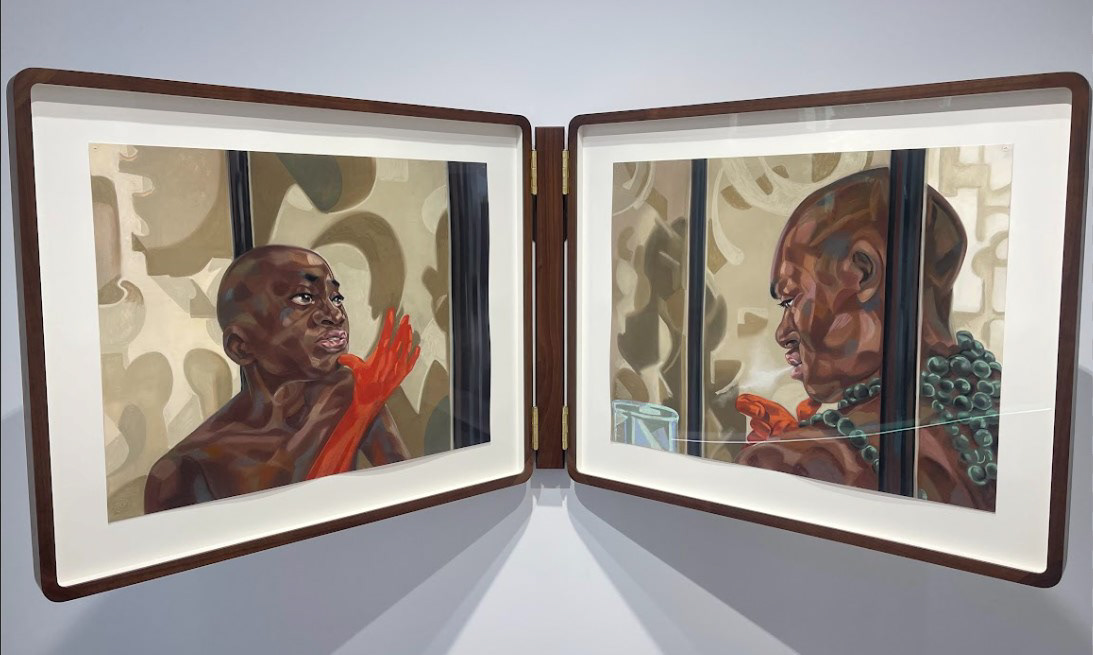First Impressions!
First of, just walking in the exhibition's physical space was dramatic - think high ceilings and arched entryways - a deliberate and theatrical use of space which added to the experience, and fit the surrealistic vibes of the paintings. The exhibition begins with the artist inviting the audience into a portal, ile Oriaku, the title of the show and a homage to her yoruba and igbo roots (yoru-igbo girlies represent) . The exhibition was designed to represent an imaginary Mbari house (a sacred ancestral space) and even though you didn't know that at first, you could immediately feel that intention as you walked in.
I really loved the significance of that entrance, it demanded attention and made you sit up a little straighter (metaphorically) as you walked into the gallery. As an artist, you have to enter a specific mental headspace to create work that flows and truly communicates your vision. So when the resulting exhibition is curated to go beyond the artworks and intentionally recreate that atmosphere of focused mental communication, it fosters a deeper connection between the work and us as viewers engaging with it.
theatrical exhibition space
Entry Statement - Ile Oriaku
What are we looking at?
These paintings felt like these are images I would see in a dream, but even so, they were quite detailed and illustrative - a style I think most people, including myself are drawn to. To me, this style evoked an exploration of the consciousness, specifically the abstractness and vastness (including the landmines) of that kind of open space. If you also have vivid and detailed dreams, maybe you know what I'm taking about.
So this is actually a question I would love to ask the artist: medium or technique? I couldn't help but notice the works are across multiple different mediums, but yet manage to create almost identical stylistic effects in each one, at least to the naked eye. ( e.g pastel, ink, charcoal etc. applied on different backdrops such as linen, paper etc) Compared to traditional oil on canvas, perhaps these materials are what create the vivid colors and the whimsical, dream-like effects? To be honest, I would guess it’s largely her technique, the consistency of style across the works is so distinct to this artist, it can't just be the materials.
The exhibition had a good variety of sizes: some pieces were small like an A4 paper (which were actually super detailed) and others were larger, more institutional style pieces, and of course, there were the centerpieces - a large triptych and a diptych in two separate gallery rooms connected by smaller (mostly) related paintings.
What makes the art fun/interesting?
Going beyond the whimsical and illustrative style, there are repeated elements in several artworks which create a really cohesive collection - you could play a fun game from spotting these things in the paintings - Mirrors on the floor, red gloved characters, beaded necklaces on ears, thin veils over ears, a dramatic, slightly sinister shadow etc.
These pieces are obviously nice to look at, but the artist LOVES a fashion moment as well (just look at the “bush woman”, lowkey a serve).
Bush woman
Pieces that made me think
1. The diptych - Lẹhin Mgbede (Before + After the Evening's Performance): This piece felt like it was summoning an energy, not just because of its large size, but also because of its arrangement: two panels positioned side by side almost like an open portal. You could also feel the energy through the characters scattered across the painting, lying in various states of anticipation or exhaustion, as if something had just happened—or was about to. Honestly, I was hesitant to walk directly in front of this piece, in case this imaginary portal suddenly opened, pulled me in, and turned me into one of the figures lying inside.
Diptych: "Lẹhin Mgbede (Before + After the Evening's Performance)"
2. “What to Ask When You Meet Your Future Self” consists of two pieces near the front of the exhibition, depicting exactly what the title suggests: a younger and older version of the same person meeting for a debrief. Naturally, the work and the title invites you to reflect on that question yourself, prompting a moment of introspection.
As you move past this and walk deeper into the exhibition, you encounter a second set of paintings titled “When Past Meets Future, will they speak the same language” which feels like a continuation of the earlier set of paintings. In this second set, the characters seem to have moved beyond simply asking questions and they are now trying to make sense of each other’s responses. You can feel the tension between them: the younger version, visibly frustrated, gestures with his hand and raises his face in questioning, while the older self remains deadpan, calmly smoking, offering no real answers (maybe they don't know the answers or maybe they just won't share....who knows?) The first set is landscape and the second set is portrait/side-by-side : I thought that arrangement might potentially reflect the shift in dynamics between these two characters. Or it could just be because the artist felt like it.

What to ask when you meet your future self?

When past meets future, will they speak the same language? Who are you?/Mother?
3. You could see a correction/clean up on "veil" (specifically an erased ear on the left) - maybe unintentional but added to that dream like effect Also just fun to see a glimpse of the behind the scenes.
Veil
4. And then there was this painting, where I genuinely could not tell what was going on. And then I look at the name and it’s titled “events you will never know” And you know what? Fair enough.
Cracked Mirror (Events You Will Never Know / ihe omume ị gaghị ama)
5. "Third person singular" - This painting made me stop and think: what are my ancestors saying, seeing? Thinking? Are they rolling in their graves at my decisions and my choices?
6. Lastly, this beautiful piece gave me pause. I already found it striking, but when I looked at it more, I had a moment of resonance because I have also created a painting about the Aba Women’s Renaissance, with similar portrayals of women wearing "wrappa" in protest. The choice to depict the bare-chested woman and the woman collapsing to the floor made perfect sense. You really cannot have a cultural collection about igbo women without a reference to a cornerstone historical movement they were at the center of.
Nwanyeruwa (Aba Women's Rebellion)
Final Thoughts
I have been following this artist’s work for a couple of years now, but this was my first time seeing an exhibit of hers in person; and I am so glad Ile Oriaku was my first. It felt like the brainchild of someone who is deeply connected to their muse/source of inspiration, drawn to them with real intention.
Overall, the exhibition was incredibly cohesive: from the thoughtful design of the entrance to the placement and arrangement of the works, which guided you through a kind of visual journey. I loved how certain elements echoed across the pieces, creating rhythm and consistency throughout.
There was a clear sense of reverence: an homage to the artist’s background and the spirituality rooted in it- but also a refreshing playfulness and light-heartedness in many of the paintings. The exhibition title, along with several of the works, referenced the artist’s Igbo and Yoruba heritage, which I also share, so it was really special to see that representation reflected here.
Shoutout to the artist, and to the gallery/curator as well.